Orbit : The paths followed by the planets around the sun and by the satellites around the planets are known as orbits.
According to Newton's first law of motion, these planets and satellites can move in circular orbits only if some force is acting on them. The mystery of the motion of all these heavenly bodies (i.e. planets and satellites) in nearly circular orbits was solved by Isaac Newton when he observed that an apple fall from a tree towards the earth. Therefore, he proposed that all particles or objects in the universe attract each other in the same manner as the earth attracted the apple.
"The force of attraction between any two particles in the universe is called gravitation or gravitation force".
Centripetal force :- The force act towards the centre is called centripetal force.
Example: Consider a girl whirling a stone along a circular
path. If the girl releases the stone at some point, the stone flies off along the tangent,
at that point on the circular path. Let us discuss this observation carefully.
Before the release of thread, the stone was moving with a certain uniform speed and
changed its direction at every point. Because of the change in direction, it moved with a
variable velocity and has some definite acceleration. The force that causes this acceleration and
makes the stone move along the circular path, acts towards the centre, i.e., towards the hand of
the girl. This force is called centripetal force. When the thread is released, the stone
does not experience the centripetal force and flies off along a straight line. This straight line
is always tangent to the circular path.
Every particle in the universe attracts every other particle with of force which is directly proportional to the product of two masses and inversely proportional to the square of the distance between them. The direction of the force is along the line joining the two masses.

i.e. Universal gravitational constant is the force of attraction (in newton) between two bodies of mass 1(kg) each lying 1(m) distance apart.
CHARACTERISTICS OF GRAVITATION FORCE :-
1. Gravitational force between two bodies or object does not need any contact between them. It means, gravitational force is action at a distance.
2. Gravitational force between two bodies varies inversely proportional to the square of the distance between them. Hence, gravitational force is an inverse square force.

UNIT OF GRAVITATIONAL CONSTANT

Do you know ?
1. The value of G = 6.67 × 10–11 N m2 kg–2 or 6.67 × 10–8 dyn cm2 g–2
2. The value of G is same through out the universe and hence G is known as universal gravitational constant.
3. Value of G was determined in laboratory by Sir Henry Cavendish.
4. Since the value of G is very small, so the gravitational force is a very weak force.
5. Gravity : The gravitional force between a body on the earth is called gravity.
IMPORTANCE OF THE UNIVERSAL LAW OF GRAVITATION
The Universal law of gravitation given by Newton has explained successfully several phenomena. For example:
1. The gravitational force of attraction of the Earth is responsible for binding all terrestrial objects on the Earth.
2. The gravitational force of the Earth is responsible for holding the atmosphere around the Earth.
3. The gravitational force of the Earth is also responsible for the rainfall and snowfall on the Earth.
4. The flow of water in rivers is also due to gravitational force of the Earth on water.
5. The moon revolves around the Earth on account of gravitational 'pull of the Earth on the Moon.
Even all artificial satellites revolve around the Earth on account of gravitational pull of the Earth on the satellites.
6. The predictions about solar and lunar eclipses made on the basis of this law always come out to be true.
The gravitational force plays an important role in nature.
7. All the planets revolve around the sun due to the gravitational force between the sun and the planets. The force required by a planet to move around the sun in circular path (known as centripetal force) is provided by the gravitational force of attraction between the planet and the sun. Thus, gravitational force is responsible for the existence of the solar system.
8. Tides in oceans are formed due to the gravitational force between the moon and the water in oceans.
9. Gravitational force between a planet and its satellite (i.e., moon) decides whether a planet has a moon or not. Since the gravitational force of the planets like mercury and venus is very small, therefore, these planets do not have any satellite or moon.
10. We stay on the earth due to the gravitational force between the earth and us.
GRAVITATIONAL FORCE BETWEEN LIGHT OBJECTS AND HEAVY OBJECTS
The formula applied for calculating gravitational force between light objects and heavy objects is the .
same, i.e., F = 
1. When two bodies of mass 1 kg each are 1 metre apart.

which is extremely small. Hence, we conclude that though every pair of two objects exert gravitational pull on each other, yet they cannot move towards eachother because this gravitational pull is too weak.
2. When a body of mass 1 kg is held on the surface of Earth.

It means that the Earth exerts a gravitational force of 9·8 N on a body of mass one kg. This force is much larger compared to the force when both the bodies are lighter. That is why when a body is dropped from a height, it falls to the Earth.
3. When both the body are heavy.

which is really large. It is this large gravitational force exerted by Earth on Moon, which makes the Moon revolve around the Earth.
Ex. Let us find force of attraction between two block lying 1m apart. Let the mass of each block is 40 kg.

1. The gravitational force between two object is 49 N. How much distance between these objects be decreased so that the force between them becomes double ?

\
2. Two bodies A and B having masses 2 kg and 4 kg respectively are seperated by 2m. Where should a body of mass 1 kg be placed so that the gravitational force on this body due to bodies A and B is zero ?


KEPLER'S LAWS OF PLANETARY MOTION
Johannes Kepler was a 16th century astronomer who established three laws which govern the motion of planets (around the sun). These are known as Kepler's laws of planetary motion. The same laws also describe the motion of satellites (like the moon) around the planets (like the earth). The Kepler's laws of planetary motion are given below.
1. KEPLER'S FIRST LAW: The planets move in elliptical orbits around the sun, with the sun at one of the two foci of the elliptical orbit.
2. KEPLER'S SECOND LAW : Each planet revolves around the sun in such a way that the line joining the planet to the sun sweeps over equal areas in equal intervals of time.
3. KEPLER'S THIRD LAW : The cube of the mean distance of a planet from the sun is directly proportional to the square of time it takes to move around the sun. The law can be expressed as : 
and T = Time period of the planet (around the sun)
Through Kepler gave the laws of planetary motion but he could not give a theory to explain the motion of planets. It was Newton who showed that the cause of the motion of planets is the gravitational force which the sun exerts on them. In fact, Newton used the Kepler's third law of planetary motion to develop the law of universal gravitation.
NEWTON'S INVERSE SQUARE RULE
The force between two bodies is inversely proportional to the square of distance between them' is called the inverse-square rule.
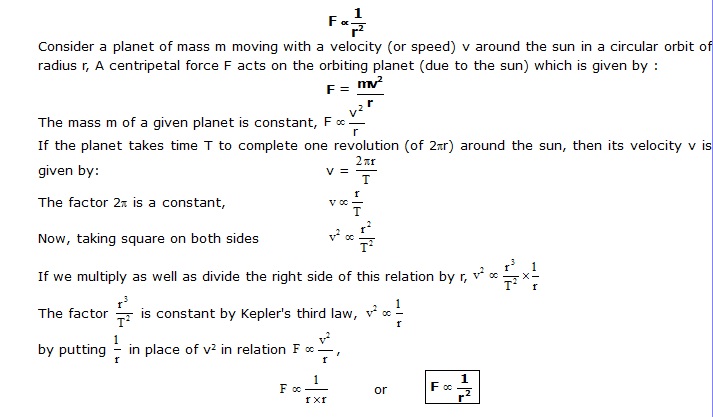
NEWTON'S THIRD LAW OF MOTION AND GRAVITATION
The Newtons third law of motion also holds good for the force of gravitation. This means that when earth exerts a force of attraction on an object, then the object also exerts an equal force on the earth, in the opposite direction.
According to Newton's second law,
Force = Mass × Acceleration
F = ma
Acceleration = Force/Mass or a = F/m
The mass of earth is very very large and acceleration produced in the earth very very small and cannot be detected with even the most accurate instrument available to us.
FREE FALL :-
Any object dropped from some height always falls towards the earth. If a feather and a stone are dropped from
the top of a tower, it is observed that feather falls onto the ground much later than the stone. So, it was thought
that object of different masses dropped from same height take different times to reach the ground.
However, Galileo dropped three iron balls of different masses simultaneously from the top of the tower of Pisa and found that all the three balls reached the earth's surface at the same time.
Galileo explained that the feather suffered much air resistance during fall because of its large surface area. Due to this opposing force, feather takes longer time to reach the ground than the stone. He further explained that if air resistance is eliminated, both feather and the stone will reach the ground simultaneously.
Conclusion :- Galileo concluded that the bodies of different masses dropped simultaneously from the same height hit the ground at the same time, if air resistance is neglected.
Definition of Free Fall :-
The falling body on which only force of gravitation of the earth acts is known as freely falling body and such fall of a body is known as free fall. A freely falling body has acceleration equal to acceleration due to graveity(g).
EXPERIMENT VERIFICATION :-
This fact was verified experimentally by Robert Boyle just after the death of Galileo. Robert Boyle 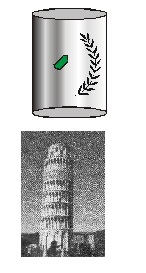
used his newly invented vacuum pump to evacuate the air from a long jar containing a lead bullet and a
feather. Then he inverted the jar and found that both the bullet and the reached the bottom of the jar at the same time.
If the air resistance is neglected or not taken into account, then the only force acting on the falling body is the force of gravitation of the earth.
This force of gravitation of the earth is constant and hence produces
a constant acceleration in the body. Since this acceleration is
produced by the gravitational force of the earth and hence known as acceleration due to gravitational force of earth or acceleration due to gravity.
ACCELERATION DUE TO GRAVITY :-
The acceleration with which a body falls towards the earth due to earth's gravitational pull is known as acceleration due to gravity. It is denoted by 'g'.
Thus, all bodies irrespective of their masses fall down with constant acceleration. DETERMINATION OF VALUE OF G

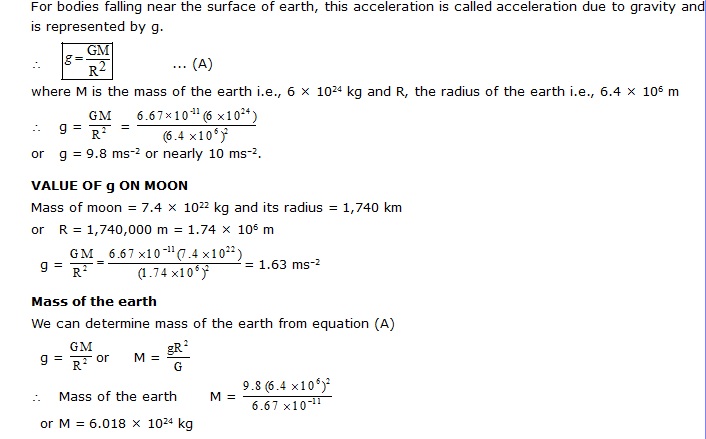
AVERAGE DENSITY OF THE EARTH
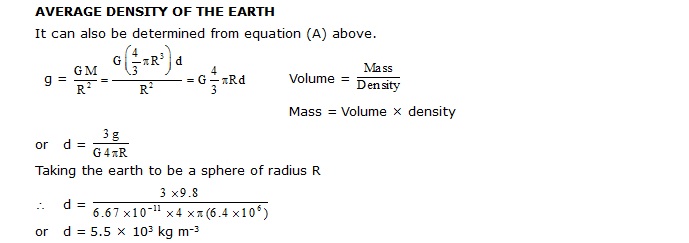
Calculation of acceleration due to gravity on the moon and to prove that it is 1/6th of the acceleration due to gravity on the earth.

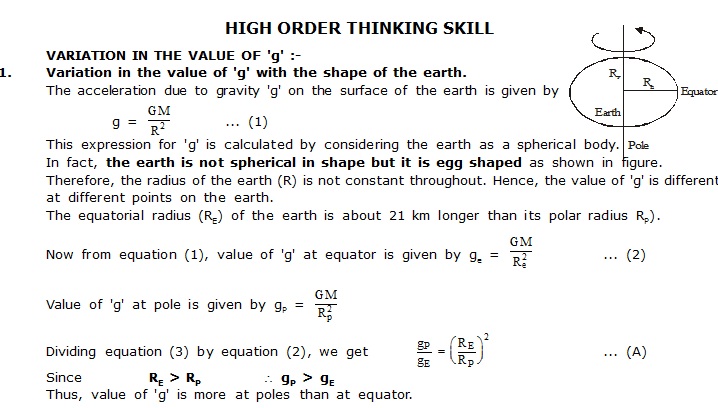
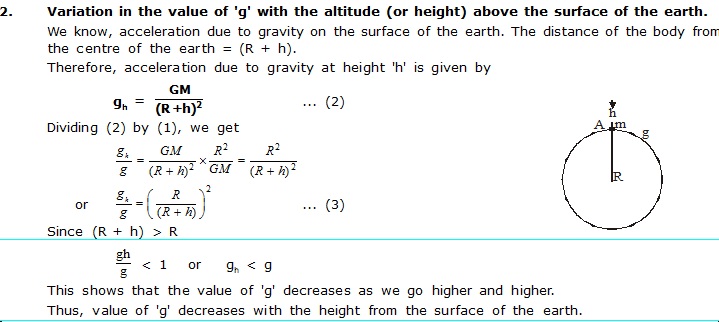
This shows that the value of 'g' decreases as we go higher and higher.
Thus, value of 'g' decreases with the height from the surface of the earth.
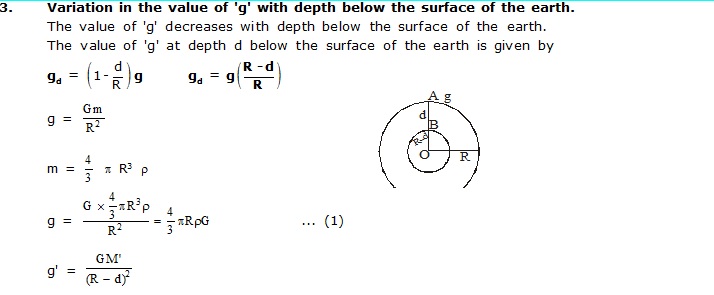
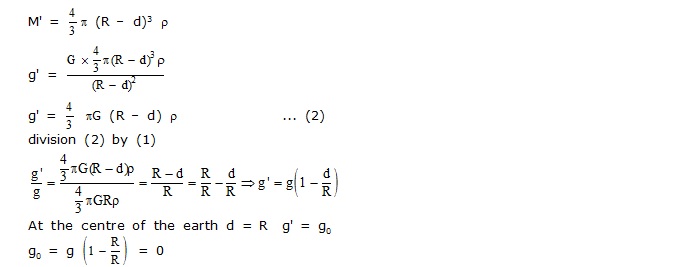
DO YOU KNOW ?
1. The acceleration due to gravity of a planet depends on its mass and its radius. Its value is high if mass is large and radius is small.
2. The value of g at the surface of earth is 9.8 ms–2 on an average.
3. The value of g decreases with height.
4. The value of g decreases with depth.
5. The value of g is more at poles and less at equator.
6. The value of g is zero at the centre of the earth.
7. The value of acceleration due to gravity is minimum at planet mercury and maximum at planet jupiter.
8. Acceleration due to gravity is independent of mass shape size etc of falling body i.e. there will be equal acceleration in a light and heavy falling body.
9. The rate of decrease of the acceleration due to gravity with height is twice as compared to that with depth.
10. If the rate of rotation of earth increases the value of acceleration due to gravity decreases at all places on the surface of the earth except at of poles.
11. If earth stops rotating there will be increase in the value of acceleration due to gravity at equator by a value =RW2 = 0.034 m/s2 but there will be no change in the value of g at poles.
Ex. Calculate the force of gravitation due to a child of mass 25 kg on his fat mother of mass 75 kg if the distance between their centres is 1m from each other. Given G = (20/3) × 10–11 Nm2 kg–2.

GRAVITATION AND GRAVITY
EQUATION OF MOTION OF FREELY FALLING BODIES
When the bodies are falling under influence of gravity, they experience acceleration g i.e., 9.8 ms–2. However, when these are going up against gravity, they move with retardation of 9.8 ms–2. All the equations of motion already read by us are valid for freely falling body with the difference that a is replaced by g. For motions vertically upwards (a) is replaced by (–g).
The equation of motion
v = u + at
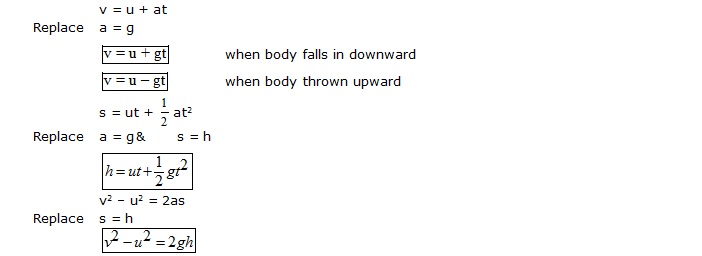
MASS
The amount of matter contained in a body is called its mass
or
The measure of the quantity of matter In a body is called its mass.
The mass of a body is a scalar quantity. It is independent of surroundings and the position of the body. It is a constant quantity for a given body.
Mass is measured in kilograms (kg) in SI system.
CHARACTERISTIC OF MASS OF A BODY :-
1. Mass of a body is proportional to the quantity of matter contained in it.
2. Mass of a body does not depend on the shape, size and the state of the body.
3. Mass of a body remains the same at all place. This means, the mass of a body will be same throughout the universe. This is because the quantity of matter contained in the body does not change throughout the universe.
4. Mass of a body does not change in the presence of other bodies near it.
5. Mass of a body is a scalar quantity.
6. Mass of a body can be measured with the help of a beam balance.
7. Masses of object or bodies are added algebraically.
WEIGHT
The force with which a body is attracted by the earth is known as the weight of the body.
When the earth attracts a body with a gravitational force, the body accelerates towards the earth with an acceleration due to gravity (g).
Thus, the force with which body of mass m is attracted by the earth is given by
F = ma = m × g = mg
This force is known as the weight of the body. Weight of a body is denoted by W.
\ Weight, W = mg
Weight has both magnitude and direction. Hence weight is a vector quantity.
Unit of Weight :-
SI unit of weight is same as that of the force i.e., newton (N).
VARIATION IN THE WEIGHT OF A BODY
Weight of the body is given by
W = mg
So the weight of a body depends upon (i) the mass of the body and (ii) value of acceleration due to gravity.
The mass of a body remains the same throughout the universe, but the value of 'g' is different places. Hence the weight of a body is different at different place.
1. The value of 'g' is more at poles and less at the equator. Therefore, weight of a body is more at the poles and less at the equator. In other words, a body weighs more at the poles and less at the equator.
2. The value of 'g' on the surfaces of different planets of the solar system is different, therefore, the weight of a body is different on the different planets.
3. The value of 'g' decreases with height from the surface of the earth. Therefore, the weight of a body also decreases with height from the surface of the earth.
That is why, the weight of a man is less on the peak of Mount Everest than the weight of the man at Delhi.
4. The value of 'g' decreases with depth from the surface of the earth. Therefore, the weight of a body decreases with depth from the surface of the earth.
5. The value of 'g' at the centre of the earth is zero, hence weight (= mg) of the body is zero at the centre of the earth.
PRACTICAL UNITS OF WEIGHT
In SI, the weight is also measured in kg f or kg wt.
Therefore, kilogram force or kilogram weight is force with which a mass of 1 kg is attracted by centre of earth.

Ex.1 What is the force of gravitation between two point masses of 1 kg and 2 kg kept 1 m apart ?

Ex.2 Calculate the force of gravitation between the earth and the sun.

Ex.3 Write down the expression for acceleration experienced by a particle on the surface of the moon due to gravitational force on the moon. Find the ratio of this acceleration to that experienced by the same particle on the surface of the earth. If the acceleration due to gravity on the earth is 9.8 ms–2, what is the acceleration of a particle on the moon's surface? Mass of moon = 7.3 × 1022 kg; Mass of
Earth = 6 × 1024 kg. Radius of moon= 1.74 × 106 m, Radius of earth = 6.4 × 106 m.
Sol. Acceleration on moon
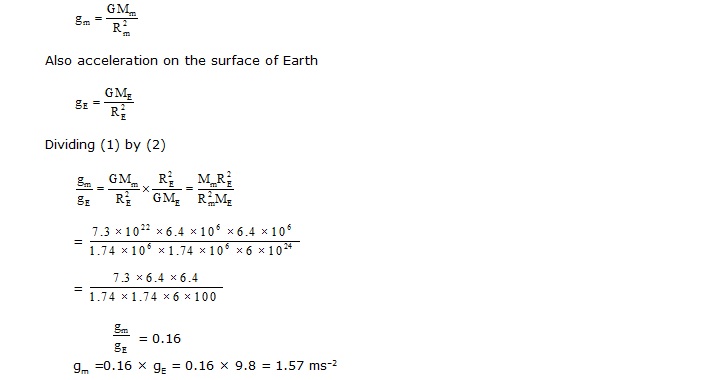
Ex.4 Find the value of acceleration due to gravity at a height of (a) 6400 km, (b) 12,800 km from the surface of the earth. Radius of earth is 6400 km.
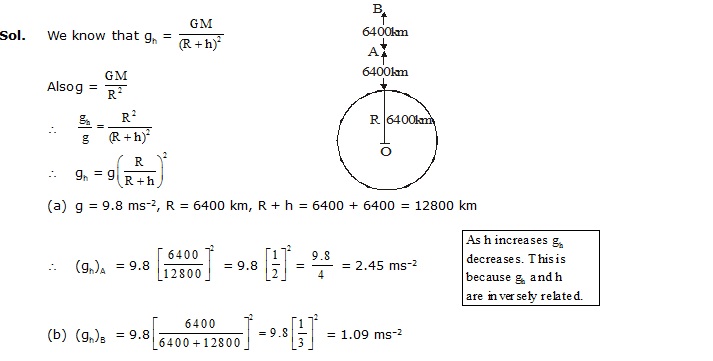
Ex.5 A particle is thrown up vertically with a velocity of 50 m/s. (a) What will be its velocity at the highest point of its journey? (b) How high would the particle rise? (c) What time would it take to reach the highest point.
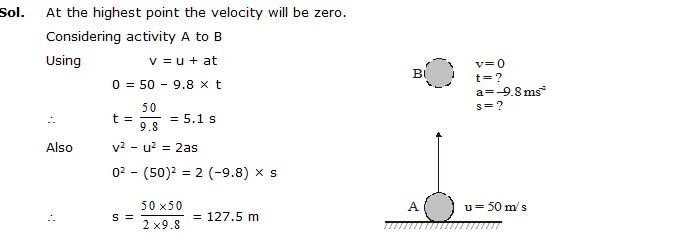
Ex.6 With reference to the above sample problem, (a) Find the time the particle takes from the highest point back to the initial point (b) Find the velocity with which the particle reaches the initial point.

Ex.7 A ball is dropped from the top of a tower 40 m high. What is its velocity when it has covered 20 m ? What would be its velocity when it hits the ground? Take g= 10 m/s2.
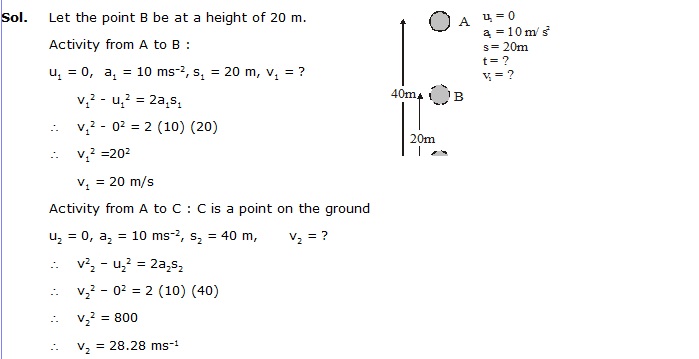
Ex.8 A body is thrown up with a speed 29.4 ms–1.
(a) What is its speed after (i) t = 1 s, (ii) t = 2 s and (iii) t = 3 s.
(b) What is its height after (i) t = 1 s, (ii) t = 2 s and (iii) t = 3 s.
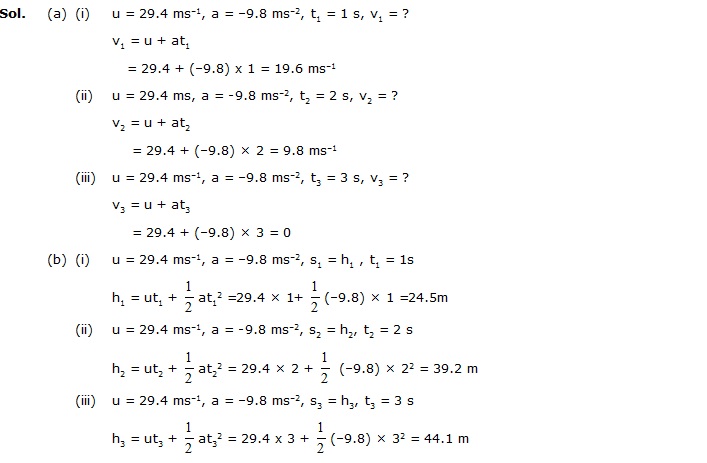
Ex.9 What is the weight of a person whose mass is 50 kg.
Sol. The weight of the person
W = mg = 50 x 9.8 = 490 N
Note: The gravitational unit of force is kg-f (kilogram force) or kg-wt (kilogram weight) 1 kg-wt = 9.8 N = 1 kg-f
\ 490 N = 50 kg-f
Ex.10 Weight of a girl is 294 N. Find her mass.
Sol. W = mg
294 = m × 9.8
m = 294/9.8= 30 kg
Ex.11 Weight of an object is 294 N on the surface of the earth. What is its weight at a height of 200 km from the surface of the earth. Radius of the earth= 6400 km.

Note: Weight decreases with increase of height from the surface of the earth.
Ex.12 The gravitational force between two objects is F. How will this force change when
(i) distance between them is reduced to half ?
(ii) the mass of each object is quadrupled ?

(ii) Again, according to Newton's law of gravitation, the gravitational force F between two'objects of masses m1 and m2 is

Ex.13 A sphere of mass 40 kg is attracted by a second sphere of mass 15 kg when their centres are 20 cm apart, with a force of 0·1 milligram weight. Calculate the value of gravitational constant.
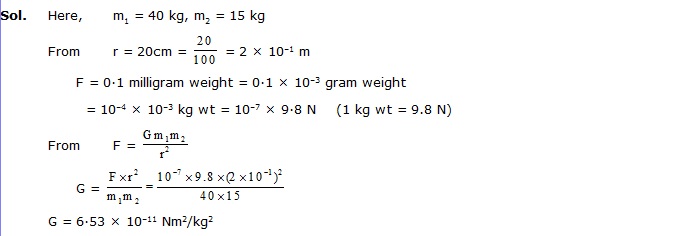
Ex.14 Calculate the force of gravity acting on your friend of mass 60 kg. Given mass of earth = 6 x 1024 kg and radius of Earth = 6·4 x 106 m.

Ex.15 A particle is thrown up vertically with a velocity of 50 m/s. What will be its velocity at the highest point of the journey? How high would the particle rise ? What time would it take to reach the highest point?
Take g = 10 m/s2.
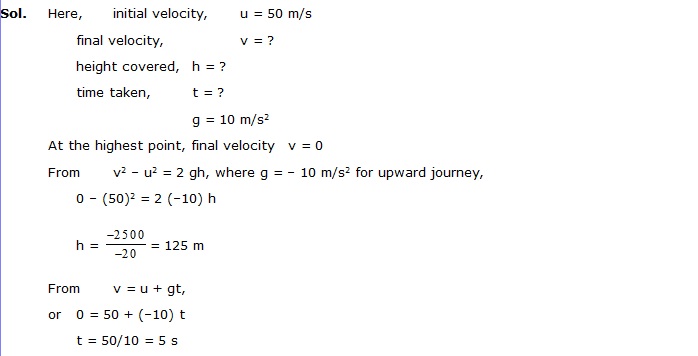
Ex.16 A force of 15 N is uniformly distributed over an area of 150 m2. Find the pressure in pascals.

Ex.17 How much force should be applied on an area of 1 cm2 to get a pressure of 15 Pa ?

Ex.18 A block weighing 1·0 kg is in the shape of a cube of length 10 cm. It is kept on a horizontal table. Find the pressure on the portion of the table where the block is kept.

Ex.19 The pressure due to atmosphere is 1·013 × 105 Pa. Find the force exerted by the atmosphere on the top surface of a table 2·0long and 1·0 m wide.
Sol. Here, pressure due to the atmosphere, P = 1·013 × 105 Pa = 1·013 x 105 N/m2
area on which atmospheric pressure acts, A = 2·0 m × 1·0 m = 2·0 m2
Thus, force exerted by the atmosphere, F = PA = (1·013 × 105 N/m2) x (2·0 m2) = 2·026 × 105 N
Ex.20 A ball thrown up is caught by the thrower after 4 s. With what velocity was it thrown up? How high did it go? Where was it after 3 s ? (g = 9.8 m s–2)
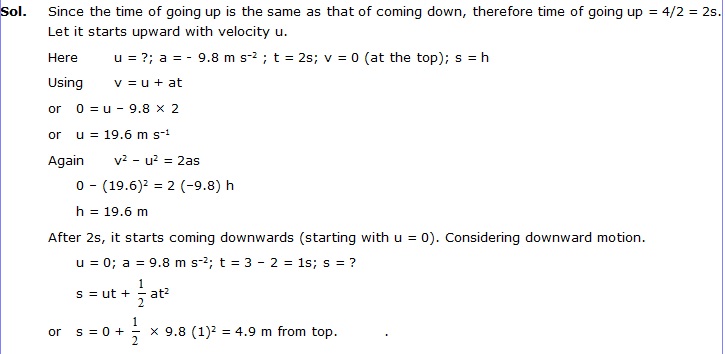 .
.
Ex.21 A boy drops a stone from the edge of the roof. If passes a window 2m high in 0.1s. How far is the roof above the top of the window ?
Sol. Let a stone be dropped from the edge of the roof A. Let it passes over B with a velocity say u. Consider motion BC.
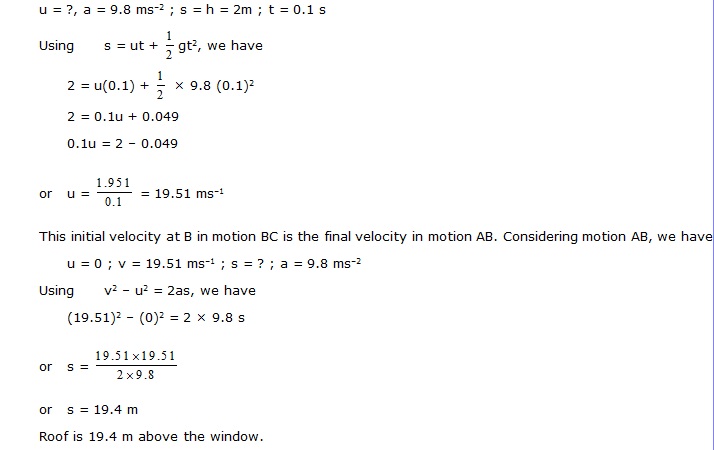
Ex.22 Coconut is hanging on a tree at a height of 15 m from the ground. A boy launches a projectile vertically upwards with a velocity of 20 m s–1. After what time the projectile pass by coconut? Explain the two answers in this problem.
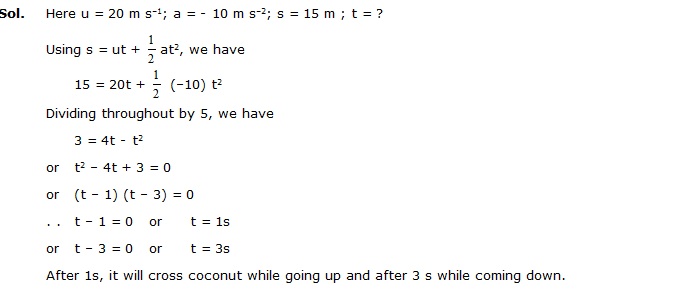
NCERT QUESTIONS WITH SOLUTIONS
Q.1 State the universal law of gravitation.
Ans. Every body in this universe attracts every other body with a force, which is directly proportional to the product of their masses and inversely proportional to the square of distance between their centers.
Q.2 Write the formula to find the magnitude of the gravitational force between the Earth and an object on the surface of this Earth.
Ans.
Where G is gravitational constant, M is the mass of the earth, m is the mass of the object. R is the distance between the centre of the object and the centre of the Earth » radius of Earth.
Q.3 What do you mean by free fall?
Ans. When an object moves with a constant acceleration, under the influence of force of gravitation of the earth only, the object is said to have free fall.
Q.4 What do you mean by acceleration due to gravity?
Ans. The acceleration produced in a body due to force of gravity is called acceleration due to gravity. It is denoted by g. The value of acceleration due to gravity is taken as 9.8 ms–2 at the sea level.
Q.5 What are the differences between the mass of an object and its weight?
Ans.
Q.6 Why is the weight of an object on the Moon of its weight on the Earth?
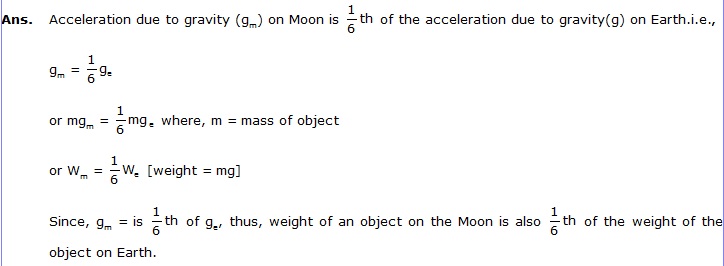 .
.
Q.7 You find your mass to be 42 kg on a weighing machine. Is your mass more or less than 42 kg?
Ans. Mass is always a constant quantity. Therefore, it cannot be more or less than 42 kg.
Q.8 How does the force of gravitation between two objects change when the distance between them is reduced to half ?
Ans. When all other variables remain constant, the force of gravitation is inversely proportional to the square of distance between the two objects.
The force of gravitation increases 4 times.
Q.9 Gravitational force acts on all objects in proportion to their masses. Why then, a heavy object does not fall faster than a light object?
Ans. A freely falling object of any mass falls under the action of gravity given by
g = , where ‘G’ is constant of gravitation, M is mass of Earth, r is the distance between the object and the centre of Earth.
Thus, the acceleration due to gravity is independent of the mass of the object.
\ All objects fall with the same acceleration towards the earth.
Q.10 What is the magnitude of the gravitational force between the Earth and a 1 kg object on its surface? (Mass of the Earth is 6 x 1024 kg and radius of the Earth is 6.4 x.106 m.)

Q.11 The Earth and the Moon are attracted to each other by gravitational force. Is the force with which the Earth attracts the Moon greater, smaller or the same as the force with which the Moon attracts the Earth ?Why?
Ans. The Earth attracts the Moon with the same force with which the Moon attracts the Earth because, the gravitational forces between any two bodies are equal and opposite (Newton's third law).
Q.12 If the Moon attracts the Earth, why does the Earth not move towards the Moon ?
Ans. The Earth does not move towards the Moon because the force exerted by the Earth or the Moon on each other is insufficient to move the Earth, on account of its huge mass.
Q.13 What happens to the force between two objects, if
(i) the mass of one object is doubled ?
(ii) the distance between the objects is doubled and tripled?
(iii) the masses of both objects ere doubled ?
Ans. (i) The force of gravitation doubles.
(ii) The force of gravitation decreases 4 times if the distance between the objects is doubled, and if the distance between the object is tripled then the force of gravitation decreases 9 times.
(iii) The force of gravitation increases 4 times.
Q.14 What is the importance of universal law of gravitation?
Ans. Importance of universal law of gravitation is as follows:
(i) It is the gravitational force between the Sun and the Earth, which makes the Earth move around the Sun.
(ii) The tides formed in sea are because of gravitational pull exerted by the Sun and the Moon on the surface of water.
(iii) It is the gravitational pull of Earth, which keeps us and other bodies firmly on the ground.
(iv) It is the gravitational pull of the Earth, which holds our atmosphere in place.
Q.15 What is the acceleration of free fall ?
Ans. The acceleration of free fall for object moving near the surface of Earth is 9.81 ms–2.
Q.16 What do we call the gravitational force between the Earth and an object ?
Ans. It is called force of gravity.
Q.17 Amit buys few grams of gold at the poles as per the instruction of one of his friends. He hands over the same when he meets him at the equator. Will the friend agree with the weight of gold bought? If not, why? [Hint: The value of g is greater at the poles than at the equator].
Ans. Weight of an object = mg, where 'm' is mass of the object.
‘g’ at equator is less than the ‘g’ at poles.
Thus, weight at equator will be less than that on poles.
So, his friend will not agree with weight of the gold at the poles when measured at equator.
Q.18 Why will a sheet of paper fall slower than one that is crumpled into a ball ?
Ans. Sheet crumpled into a ball has small surface area as compared to the similar unfolded sheet. Therefore, unfolded sheet will experience more resistance due to air as compared to the sheet crumpled into a ball, inspite of same force of gravity acting upon them. It is larger resistance of air which slows down the unfolded sheet, and therefore it falls slower as compared to sheet crumpled into a ball.
Q.19 Gravitational force on the surface of the Moon is only as strong as gravitational force on the Earth. What is the weight in newton of a 10 kg object on the Moon and on the Earth?

Q.20 A ball is thrown vertically upwards with a velocity of 49 ms–1. Calculate
(i) The maximum height to which it rises.
(ii) The total time it takes to return to the surface of the Earth.
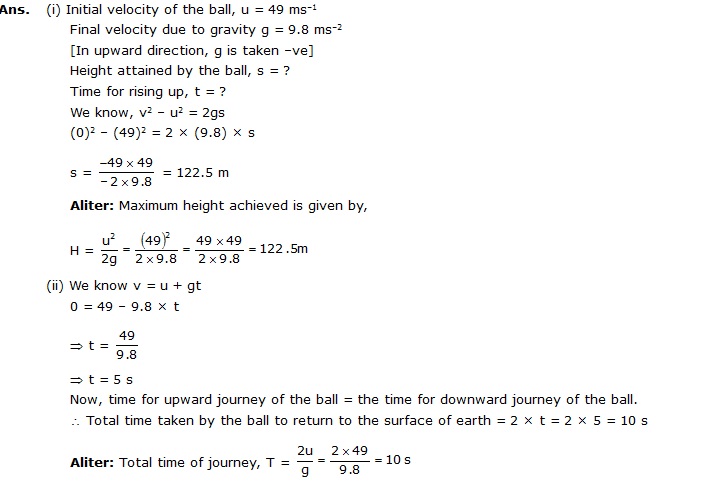
Q.21 A stone is thrown vertically upward with an initial velocity of 40 ms–1. Taking 9 10 ms–2, find the maximum height reached by the stone. What is the net displacement and the total distance covered by the stone?
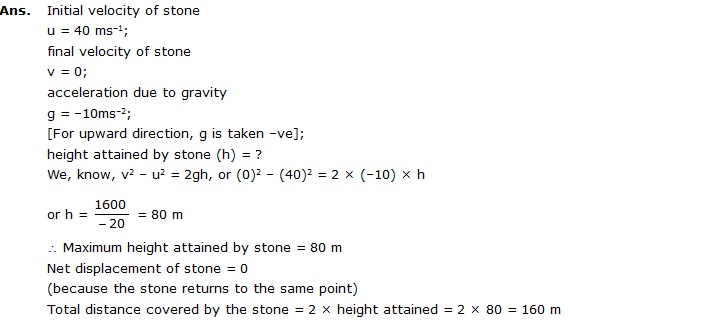
Q.22 A stone is released from the top of a tower of height 19.6 m. Calculate its final velocity just before touching the ground.

Q.23 Calculate the force of gravitation between the Earth and the Sun, given that the mass of the Earth = 6 × 1024 kg and of the Sun = 2 × 1030 kg. The average distance between the two is 1.5 × 1011 m.

Q.24 A stone is allowed to fall from the top of a tower 100 m high and at the same time another stone is projected vertically upwards from the ground with a velocity of 25 ms-I. Calculate when and where the two stones will meet. [take g = 10 m/s2)
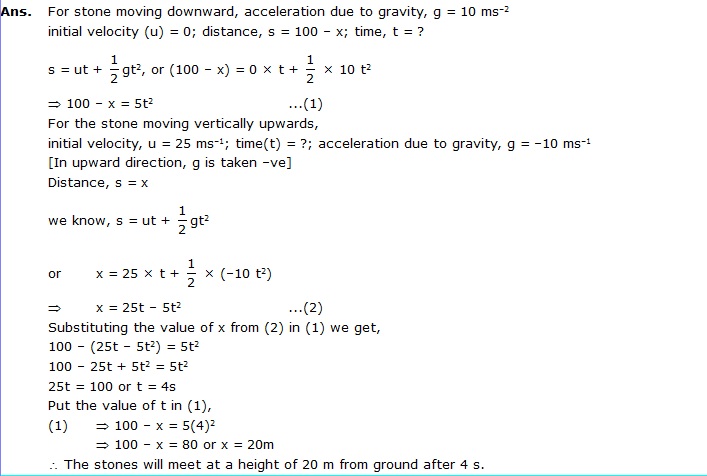 .
.
Q.25 A ball thrown up vertically returns to the thrower after 6s. Find.
(a) the velocity with which it was thrown up
(b) the maximum height it reaches, and
(c) its position after 4s(take g = 10 m/s2)
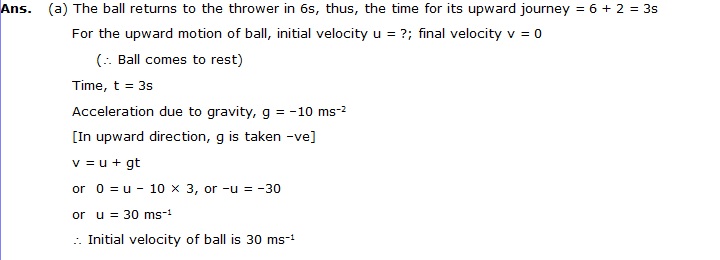
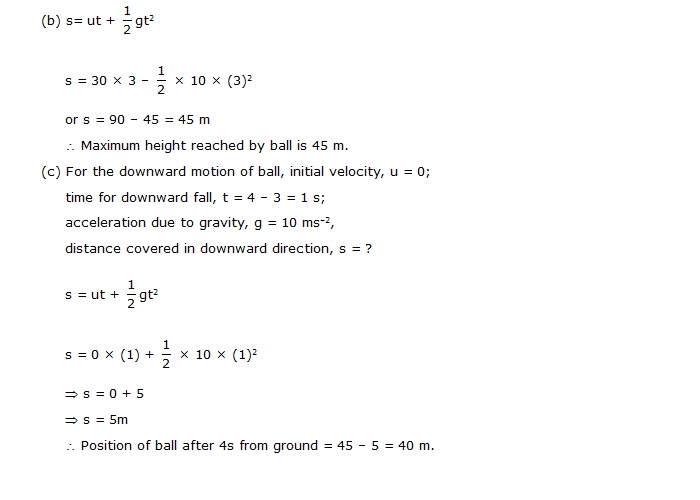
VERY SHORT ANSWER TYPE QUESTIONS
Q.1 Who gave the Universal law of gravitation
Q.2 What do you mean by gravitation ?
Q.3 State Universal law of gravitation.
Q.4 Write an expression for the gravitational force between the earth and a body on the earth.
Q.5 The distance between two particles is decreased. Will the gravitational force between them increase or decrease?
Q.6 An iron ball exerts a force F on the rubber ball. How much force, the, rubber ball will exert on the iron ball ?
Q.7 Define Universal gravitational constant (G)..
Q.8 Write down the unit of ‘G’ in S.I.
Q.9 What is the value of ‘G’ ?
Q.10 The value of G = 6.673 × 10–11 Nm2 kg–2 on the surface of the earth. What is the value of G on the surface of the moon ?
Q.11 The gravitational force between the earth and an object is known as ............
Q.12 The gravitational force between two objects on the earth is 2 N. What will be the gravitational force between these two objects on the surface of the moon ?
Q.13 Tides in oceans are formed due to gravitational force between ...........and.............
Q.14 Name the force which is responsible for the revolution of planets around the sun.
Q.15 Name the force which is responsible for the revolution of moon around the earth.
Q.16 How does the gravitational force between two bodies varies with r ?
Q.17 Is acceleration due to gravity on the surface of moon less or more than the acceleration due to gravity on the surface of earth ?
Q.18 Write the expression for the acceleration due to gravity. g = GM/R2
Q.19 What is the SI unit of acceleration due to gravity (g)
Q.20 What is the value of acceleration due to gravity on the surface of earth ?
Q.21 Is acceleration due to gravity a scalar or a vector quantity ?
Q.22 What is the value of acceleration due to gravity on the surface of moon ?
Q.23 Acceleration due to gravity on the surface of moon = ........ × Acceleration due to gravity on the surface of the earth.
Q.24 Where is the acceleration due to gravity more : at poles or at equator ?
Q.25 What is the value of 'g' at the centre of the earth ?
Q.26 What will be the direction of acceleration due to gravity if the body is thrown vertically upward?
Q.27 Define mass of a body.
Q.28 Why is mass known as inertial mass ?
Q.29 What is the SI unit of mass ?
Q.30 Is mass of a body a scalar or a vector physical quantity.
Q.31 The mass of a body at the equator is 20 kg. What will be the mass of this body at the poles?
Q.32 Define weight of a body.
Q.33 Write a relation between the mass and weight of the body.
Q.34 State the SI unit of weight.
Q.35 Is weight of a body a scalar or a vector quantity?
Q.36 The weight of a body on the earth is 60 N. What is the weight of the body on the moon?
Numerical Problems
Q.1 What is the gravitational acceleration of a spaceship at a distance equal to two Earth's radius from the centre of the Earth?
Q.2 A boy on a cliff 49 m high drops a stone. One second later, he throws a second stone after the ftrst. They both hit the ground at the same time. With what speed did he throw the second stone ?
Q.3 A stone drops from the edge of the roof. It passes a window 2 m high in 0·1 s. How far is the roof above the top of the window?
Q.4 A particle is dropped from a tower 180 m high. How long does it take to reach the ground? What is the velocity when it touches the ground? Take g = 10 m/s2.
Q.5 To estimate the height of a bridge over a river, a stone is dropped freely on the river from the bridge. The stone takes 2 s to touch the water surface in the river. Calculate the height of the bridge from the water level. Take
g = 9·8 m/s2.
Q.6 How much would a 70 kg man weigh on moon? What will be his mass on Earth and Moon? Given g on Moon = 1·7 m/s2.
Q.7 A body has a weight of 10 kg on the surface of Earth. What will be its mass and weight when taken to the centre of Earth?
Q.8 A force of 2 kg wt acts on a body of mass 4·9 kg. Calculate its acceleration.
Q.9 A force of 20 N acts upon a body whose weight is 9·8 N. What is the mass of the body and how much is its acceleration ?
Q.10 A man weighs 600 N on the Earth. What is its mass? Take g = 10 m/s2. If he were taken on Moon, his weight would be 100 N. What is his mass on Moon? What is acceleration due to gravity on Moon?
Q.11 A car falls off a ledge and drops to the ground in 0·5 s. Let g = 10 m/s2 (for simplifying the calculations). (i) What is its speed on striking the ground? (ii) What is its average speed during
0·5 s? (iii) How high is the ledge from the ground?
Q.12 An object is thrown vertically upwards and rises to a height of 10 m. Calculate (i) the velocity with which the object was thrown upwards and (ii) the time taken by the object to reach the highest point.
Q.13 Mass of an object is 10 kg. What is its weight on Earth?
Q.14 An object weighs 10 N when measured on the surface of the Earth. What would be its weight when measured on the surface of Moon ?
Q.15 Calculate the value of acceleration due to gravity on Moon. Given mass of Moon = 7·4 × 1022 kg, radius of Moon = 1740 km.
Q.16 Suppose a planet exists whose mass and radius both are half those of Earth. Calculate the acceleration due to gravity on the surface of this planet.
Q.17 A ball is thrown up with a speed of 15 m/s. How high will it go before it begins to fall? Take g = 9·8 m/s2.
Q.18 How does the force of gravitation between two objects change when the distance between them is reduced to half?
Q.19 Gravitational force acts on all objects in proportion to their masses. Why then, a heavy object does not fall faster than a light object?
Q.20 What is the magnitude of the gravitational force between the earth and a 1 kg object on its surface? (Mass of the earth is 6 × 1024 kg and radius of the earth is 6.4 × 106 m.)
Q.21 Gravitational force on the surface of the moon is only as strong as gravitational force on the earth. What is the weight in newtons of a 10 kg object on the moon and on the earth?
Q.22 A ball is thrown vertically upwards with a velocity of 49 m/s.
Calculate
(i) the maximum height to which it rises,
(il) the total time it takes to return to the surface of the earth.
Q.23 A stone is released from the top of a tower of height 19.6 m. Calculate its final velocity just before touching the ground.
Q.24 A stone is thrown vertically upward with an initial velocity of 40 m/s. Taking g = 10 m/s2, find the maximum height reached by the stone. What is the net displacement and the total distance covered by the stone?
Q.25 Calculate the force of gravitation between the earth and the Sun, given that the mass of the earth = 6 × 1024 kg and of the Sun = 2 × 1030 kg. The average distance between the two is 1.5 × 1011 m.
VERY SHORT ANSWER TYPE QUESTIONS
1. Issac Newton gave the universal law of gravitation.
2. The force of attraction between any two particles in the universe is called gravitation.
3. The force of attraction between two particles or objects is (i) directly proportional to the product of the masses of the objects and (ii) inversly proportional to the square of the distance between them.
4. F= GMm/r2 , where M is the mass of the earth, m is the mass of the body, r is the radius of the earth and G is

6. The rubber ball also exerts the same force F on the iron ball.
7. Universal gravitational constant is defined as the force of attraction between two objects of unit masses separated by unit distance.
8. Nm2 /kg2.
9. G= 6.673 × 10–11 Nm2/Kg2.
10. The value of G on the surface of the moon = value of G on the surface of the earth (i.e., 6.673 × 10–11 Nm2 kg–2)
11. Gravity or force of gravity.
12. Same force i.e. 2 N.
13. the moon, the earth.
14. Gravitational force of attraction between the planet and the sun. This force provides the necessary centripetal force to the planet to move in a circular orbit around the sun.
15. The Gravitational force between the earth and the moon provides the centripetal force to the moon to move in a circular path around the earth.
16. (b)
17. Acceleration due to gravity on the surface of the moon is less than that on the surface of the earth.
19. ms–2
20. g = 9.8 ms–2
21. It is a vector quantity.
22. g = 1.6 ms–2 on the surface of moon.
23. 1/6
24. At poles
25. Zero.
26. The direction of acceleration due to gravity is always towards the centre of the earth i.e. in the downward direction.
27. Mass of a body is defined as the quantity of matter contained in the body.
28. Since mass is a measure of the inertia of a body, so the mass is known as inertial mass.
29. S.I. unit of mass is kilogram
30. Mass is a scalar physical quantity.
31. 20 kg.
32. The force with which a body is attracted by the earth is known as the weight of the body.
33. W = mg
34. S.I. unit of weight is newton (N).
35. Weight is a vector quantity.
36. Weight on the moon = 1/6 × 60 N = 10 N
NUMERICAL PROBLEMS
1. 2.45 m/s2 2. 12·1 m/s
3. 19·4 m
4. 6 s, 60 m/s 5. 19·6 m
6. 119 N, 70 kg, 70 kg
7. 10 kg, Zero 8. 4 m/s2
9. 1 kg, 20 m/s2
10. 60 kg, 60 kg, 1·67 m/s2
11. (i) 5 m/s (ii) 2·5 m/s (iii) 1·25 m)
12. 14 m/s, 1·43 s 13. 98 N
14. 1·67 N
15. 1·63 m/s2 16. 19·6 m/s2
17. 11·48 m
20. 4F
21. anet = g 22. 9.8 N
23. Weight on earth is 98 N and on moon is 16.3 N
24. Maximum height is 122.5 m and total time is 5s + 5 = 10s
25. 19.6 m/s
26. Maximum height = 80m, Net displacement = 0, Total distance covered = 160 m
27. Gravitational force = 53.36 × 1032 N
EXERCISE-II
Q.1 Value of free fall acceleration is:
(A) 9.8 m/s2 (B) 9.8 m/s
(C) 9.8 km/s2 (D) zero
Q.2 The acceleration due to gravity
(A) has the same value everywhere in space
(B) has the same value everywhere on the earth
(C) varies with the latitude on the earth
(D) is greater on the moon due to its smaller diameter
Q.3 SI unit of weight is
(A) kg wt (B) N
(C) g wt (D) none of these
Q.4 Gravitational force which acts on 1 kg is
(A) 9.8 N (B) N
(C) 980 N (D) none of these
Q.5 Weight is
(A) measured by a spring balance
(B) measured by a beam balance
(C) measured in kg
(D) a scalar quantity
Q.6 A satellite which is geostationary in a particular orbit is taken to another orbit. Its distance from the centre of earth in new orbit is 2 times than that of the earlier orbit. The time period in the second orbit is

Q.7 Two metal spheres of equal radius r are touching each other. The force of attraction F between them is
(A) F µ r4 (B) F µ r6
(C) F µ r2 (D) F µ
Q.8 A man weighs 60 kg at earth's surface. At what height above the earth's surface his weight becomes 30 kg? (radius of earth = 6400 km).
(A) 1624 km (B) 2424 km
(C) 2624 km (D) 2826 km
Q.9 There are two bodies of masses 100 kg and 10000 kg separated by a distance 1m. At what distance from the smaller body, intensity of gravitational field will be zero?
(A) m (B) m
(C) m (D) m
Q.10 At what height, is the value of g half that on the surface of earth? (R = radius of the earth)
(A) 0.414R (B) R
(C) 2R (D) 3.5R
Q.11 A planet of mass m moves around the sun of mass M in an elliptical orbit. The maximum and minimum distances of the planet from the sun are r1 and r2 respectively. The time period of the planet is proportional to

Q.12 On a planet (whose size is the same and mass 4 times as that of the earth), the energy needed to lift a 2 kg mass vertically upwards through 2 m distance on the planet is (g = 10 m/s2 on the surface of the earth)
(A) 16 joules (B) 160 joules
(C) 32 joules (D) 320 joules
Q.13 A satellite is revolving in a circular orbit at a distance of 2620 km from the surface of the earth. The time period of revolution of the satellite is (Radius of the earth = 6380 km, mass of the earth = 6 × 1024 kg, G = 6.67 × 10–11 N-m2/kg2)
(A) 2.35 hours (B) 23.5 hours (C) 3.25 hours (D) 32.5 hours
Q.14 On the surface of the earth, force of gravitational attraction between two masses kept at distance d apart is 6 Newtons. If these two masses are taken to the surface of the moon and kept at the same distance d, the force between them will be
(A) 1N (B) 36N
(C) 1/6N (D) 6N
Q.15 Time period of simple pendulum in a satellite is
(A) infinite (B) zero
(C) 2 sec (D) cannot be calculated
Q.16 A ball is dropped from a spacecraft revolving around the earth at height of 120 km. What will happen to the ball ?
(A) It will continue to move with the same speed along the original orbit of spacecraft
(B) It will move with the same speed, tangentially to the spacecraft
(C) It will fall down to the earth gradually
(D) It will go very far in space
Q.17 The value of the acceleration due to gravity at a height of 12,800 km from the surface of the earth (Re = 6400 km) g' = g  is :-
is :-
(A) 3.09 m/s2 (B) 1.09 m/s2
(C) 4.08 m/s2 (D) 5.07 m/s2
Q.18 The weight of a body of mass 5 kg is :-
(A) 69.0 N (B) 79.0 N
(C) 49.0 N (D) 39.0 N
Q.19 The weight of the body at the surface of the earth is 20 N and the radius of the earth is 6400 km. The weight of a body at a height 6400 km above is :-
(A) 7 N (B) 5 N
(C) 4 N (D) 6 N
Q.20 Consider a heavenly body which has a mass twice that of the earth and a radius thrice that of the earth. The weight of a book on this heavenly body, if its weight on the earth is 900 N will be :-
(A) 400 N (B) 600 N
(C) 500 N (D) 200 N
Q.21 Two protons are kept at a separation of 1 femtometre (1 femtometre = 10–15 m). The mass of a proton is 1.67 × 10–27 kg. The gravitational force between them is :-
(A) 1.86 × 10–34 N (B) 5.86 × 10–34 N (C) 2.8 × 10–34 N (D) 4.86 × 10–34 N
Q.22 The mass of the sun is 2.0 × 1036 kg and that of the earth is 6.0 × 1024 kg. The distance between the sun and the earth is 1.5 × 1011 m. The gravitational force between the sun and earth is:-
(A) 3.56 × 1028 N (B) 4.56 × 1028 N (C) 6.56 × 1028 N (D) 5.56 × 1028 N
Q.23 A particle is taken to a height of 2Re above the earth's surface, where Re is the radius of the earth. If it is dropped from this height, its acceleration is will be :-
(A) 3.1 m/s2 (B) 5.1 m/s2
(C) 1.1 m/s2 (D) 2.1 m/s2
Q.24 Consider a heavenly body whose mass is 3 × 1024 kg (half of that of the earth) and radius is 3200 km (half of that of the earth). The accelerating due to gravity at the surface of this heavenly body will be :-
(A) 39.6 m/s2 (B) 19.6 m/s2
(C) 29.6 m/s2 (D) 49.6 m/s2
Q.25 Two bodies 'A' and 'B' having masses 'm' and '2m' respectively are kept at a distance 'd' apart. A small particle is to be placed so that the net gravitational force on it, due to the bodies A and B, is zero. Its distance from the mass A should be :-

Q.26 Two bodies of masses 1 kg and 2 kg respectively are placed at a separation of 1 m. Find the accelerations of the bodies assuming that only gravitational force acts between them :-
(A) 1.33 × 10–10 & 6.67 × 10–11 m/s2 (B) 1.33 × 10–11 & 6.25 × 10–11 m/s2
(C) 5.36 × 10–11 & 5.26 × 10–11 m/s2 (D) 3.11 × 10–11 & 5.26 × 10–11 m/s2
Q.27 Communication satellites move in the orbits of radius 44,400 km around the earth. The acceleration of such a satellite assuming that the only force acting on it is that due to the earth is :-
(A) 0.4 m/s2 (B) 0.6 m/s2
(C) 0.2 m/s2 (D) 0.1 m/s2
Q.28 Two persons weighing 50 kg and 60 kg are seated across a table. If they are one metre apart, the gravitational force between them is:-
(A) 5 × 10–7 N (B) 2 × 10–7 N (C) 4 × 10–7 N (D) 3 × 10–7 N
Q.29 The mass of a planet is twice and its radius is 3 times that of the earth. The weight of a body, which has a mass of 5 kg on the surface of the earth, on that planet is :-
(A) 11.95 N (B) 20.9 N
(C) 10.85 N (D) 9.9 N
Q.30 The height at which a body has one fourth of its weight when it is on the surface of the earth is :-
(A) At a height r where r is the radius of the earth
(B) At a height 2r where r is the radius of the earth
(C) At a height r/2 where r is the radius of the earth
(D) At a height r/4 where r is the radius of the earth
Q.31 A space vehicle is moving vertically upward with a constant acceleration 'a'. An astronaut of weight 'mg' feels heavier. When will the astronauts weight becomes 2 mg ?
(A) a = 2g (B) a = g/2
(C) a = g (D) a = 3g
Q.32 Two bodies A and B of masses 100 g and 200 g respectively are dropped near the earth's surface. Let the accelerations of A and B be 'a1' and 'a2' respectively. Then :

Q.33 At what height will a man's weight be half his weight on the surface of earth ? (R is the radius of earth)
(A) 0.214 R (B) 0.514 R
(C) 0.414 R (D) 0.516 R
Q.34 If the radius of the earth were to be increased by a factor of 3, by what factor would its density have to be changed to keep 'g' the same ?
(A) 3 (B) 1/3
(C) 6 (D) 1/6
Q.35 Variation of 'g' w.r.t. height or depth is correctly represented by :-
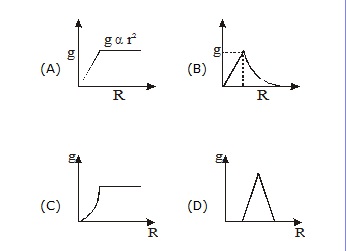
Q.36 If a rock is brought from the surface of the moon,
(A) its mass will change
(B) its weight will change but not mass
(C) both mass and weight will change (D) its mass and weight both will remain same
Q.37 A body is weighed at the poles and then at the equator. The weight
(A) at the equator will be greater than at the poles
(B) at the poles will be greater than at the equator
(C) at the poles will be equal to the weight at the equator
(D) depends upon the object
Q.38 Consider a satellite going round the earth in a circular orbit. Which of the following statements is wrong ?
(A) It is a freely falling body.
(B) It is moving with constant speed.
(C) It is acted upon by a force directed away from the centre of the earth which counter-balances the gravitational pull
(D) Its angular momentum remains constant
Q.39 A missile is launched with a velocity less than the escape velocity. The sum of its kinetic and potential energy is
(A) positive (B) negative
(C) zero (D) may be positive or negative depending upon its initial velocity
Q.40 SI unit of g is
(A) m2/s (C) s/m2
(B) m/s2 (D) m/s
Q.41 SI unit of G is
(A) N2–m2/kg (B) N–m2/kg
(C) N–m/kg (D) N -m2/kg2
Q.42 Choose the correct statement of the following:
(A) All bodies repel each other in this universe. (B) Our earth does not behave like a magnet.
(C) Acceleration due to gravity is 8.9 m/s2. (D) All bodies fall at the same rate in vacuum.
Q.43 Maximum weight of a body is
(A) at the centre of the earth
(B) inside the earth
(C) on the surface of the earth
(D) above the surface of earth
Q.44 If the distance between two masses be doubled, then the force between them will become
(A) 1/4 times (B) 4 times
(C) 1/2 times (D) 2 times
Q.45 A body falls freely towards the earth with
(A) uniform speed
(B) uniform velocity
(C) uniform acceleration
(D) none of these
Q.46 If the mass of a body is M on the surface of the earth, then its mass on the surface of the moon will be
(A) M/6 (B) M
(C) M + 6 (D) zero
Q.47 Weight
(A) is a vector quantity
(B) of a body in interplanetary space is maximum
(C) increases when the bodies go up (D) none of these
Q.48 The value of g near the earth's surface is
(A) 8.9 m/s2 (B) 8.9 m/s
(C) 9.8 m/s2 (D) 9.8 m/s
Q.49 A geostationary satellite
(A) moves faster than the near earth satellite
(B) has a time period less that of a near earth satellite
(C) revolves about the polar axis
(D) is stationary in space
Q.50 The force of gravitation between two bodies depend upon
(A) their separation
(B) gravitational constant
(C) product of their masses
(D) all of these
Q.51 When an object is thrown up, the force of gravity
(A) acts in the direction of the motion (B) acts in the opposite direction of the motion
(C) remains constant as the body moves up (D) increases as the body moves up
Q.52 The force of gravitation exists
(A) everywhere in the universe
(B) at the surface of the earth only
(C) inside the earth only
(D) at the surface of the moon only
Q.53 1 kg wt is equal to
(A) 9.8 N (B) 980N
(C) 98 N (D) none of these
Q.54 1 kg wt is equal to
(A) 980 dynes (B) 9.80 dynes (C) 98 dynes (D) none of these
Q.55 The value of G does not depend on
(A) nature of the interacting bodies
(B) size of the interacting bodies
(C) mass of the interacting bodies
(D) all of these
ANSWERS
1. A 2. C 3. B 4. A
5. A 6. B 7. D 8. C
9. C 10. A 11. C 12. B
13. A 14. D 15. A 16. A
17. B 18. C 19. B 20. D
21. A 22. A 23. C 24. B
25. A 26. A 27. C 28. B
29. C 30. A 31. C 32. A
33. C 34. B 35. B 36. b
37. b 38. C 39. b 40. b
41. D 42. D 43. C 44. A
45. C 46. B 47. A 48. C
49. C 50. D 51. B 52. A
53. A 54. A 55. D
EXERCISE - III
1. The mass of the Jupiter is 1.9 × 1027 kg and that of the sun is 1.99 × 1038 kg. The mean distance of the Jupiter from the sun is 7.8 × 1011 m. Speed of the Jupiter is (assuming that Jupiter moves in a circular orbit around the sun)
(A) 1.304 × 104 m/sec (B) 13.04 × 104 m/sec
(C) 1.304 × 106 m/sec (D) 1.304 × 102 m/sec
2. The acceleration due to gravity
(A) has the same value everywhere in space
(B) has the same value everywhere on the earth
(C) varies with the latitude on the earth
(D) is greater on the moon due to its smaller diameter
3. SI unit of weight is
(A) kg wt (B) N (C) g wt (D) none of these
4. Gravitational force which acts on 1 kg is
(A) 9.8 N (B) N (C) 980 N (D) none of these
5. Weight is
(A) measured by a spring balance (B) measured by a beam balance
(C) measured in kg (D) a scalar quantity
6. A satellite which is geostationary in a particular orbit is taken to another orbit. Its distance from the centre of earth in new orbit is 2 times than that of the earlier orbit. The time period in the second orbit is

7. Two metal spheres of equal radius r are touching each other. The force of attraction F between them is
![]()
8. A man weighs 60 kg at earth's surface. At what height above the earth's surface his weight becomes 30 kg? (radius of earth = 6400 km).
(A) 1624 km (B) 2424 km
(C) 2624 km (D) 2826 km
9. There are two bodies of masses 100 kg and 10000 kg separated by a distance 1m. At what distance from the smaller body, intensity of gravitational field will be zero?
(A) m (B) m (C) m (D) m
10. At what height, is the value of g half that on the surface of earth? (R = radius of the earth)
(A) 0.414R (B) R (C) 2R (D) 3.5R
11. A planet of mass m moves around the sun of mass M in an elliptical orbit. The maximum and minimum distances of the planet from the sun are r1 and r2 respectively. The time period ofthe planet is proportional to

12. On a planet (whose size is the same and mass 4 times as that of the earth), the energy needed to lift a 2 kg mass vertically upwards through 2 m distance on the planet is (g = 10 m/s2 on the surface of the earth)
(A) 16 joules (B) 160 joules (C) 32 joules (D) 320 joules
13. A satellite is revolving in a circular orbit at a distance of 2620 km from the surface of the earth. The time period of revolution of the satellite is (Radius of the earth = 6380 km, mass of the earth = 6 × 1024 kg, G = 6.67 × 10–11 N-m2/kg2)
(A) 2.35 hours (B) 23.5 hours (C) 3.25 hours (D) 32.5 hours
14. On the surface of the earth, force of gravitational attraction between two masses kept at distance d apart is
6 Newtons. If these two masses are taken to the surface of the moon and kept at the same distance d, the force between them will be
(A) 1N (B) 36N (C) N (D) 6N
15. Time period of simple pendulum in a satellite is
(A) infinite (B) zero (C) 2 sec (D) cannot be calculated
16. A ball is dropped from a spacecraft revolving around the earth at height of 120 km. What will happen to the ball ?
(A) It will continue to move with the same speed along the original orbit of spacecraft
(B) It will move with the same speed, tangentially to the spacecraft
(C) It will fall down to the earth gradually
(D) It will go very far in space
17. The value of the acceleration due to gravity at a height of 12,800 km from the surface of the earth
(Re = 6400 km) g' = g is :-
(A) 3.09 m/s2 (B) 1.09 m/s2 (C) 4.08 m/s2 (D) 5.07 m/s2
18. The weight of a body of mass 5 kg is :-
(A) 69.0 N (B) 79.0 N (C) 49.0 N (D) 39.0 N
19. The weight of the body at the surface of the earth is 20 N and the radius of the earth is 6400 km. The weight of a body at a height 6400 km above is :-
(A) 7 N (B) 5 N (C) 4 N (D) 6 N
20. Consider a heavenly body which has a mass twice that of the earth and a radius thrice that of the earth. The weight of a book on this heavenly body, if its weight on the earth is 900 N will be :-
(A) 400 N (B) 600 N (C) 500 N (D) 200 N
21. Two protons are kept at a separation of 1 femtometre (1 femtometre = 10–15 m). The mass of a proton is
1.67 × 10–27 kg. The gravitational force between them is :-
(A) 1.86 × 10–34 N (B) 5.86 × 10–34 N (C) 2.8 × 10–34 N (D) 4.86 × 10–34 N
22. The mass of the sun is 2.0 × 1036 kg and that of the earth is 6.0 × 1024 kg. The distance between the sun and the earth is 1.5 × 1011 m. The gravitational force between the sun and earth is :-
(A) 3.56 × 1028 N (B) 4.56 × 1028 N (C) 6.56 × 1028 N (D) 5.56 × 1028 N
23. A particle is taken to a height of 2Re above the earth's surface, where Re is the radius of the earth. If it is dropped from this height, its acceleration is will be :-
(A) 3.1 m/s2 (B) 5.1 m/s2 (C) 1.1 m/s2 (D) 2.1 m/s2
24. Consider a heavenly body whose mass is 3 × 1024 kg (half of that of the earth) and radius is 3200 km (half of that of the earth). The acceleratin due to gravity at the surface of this heavenly body will be :-
(A) 39.6 m/s2 (B) 19.6 m/s2 (C) 29.6 m/s2 (D) 49.6 m/s2
25. Two bodies 'A' and 'B' having masses 'm' and '2m' respectively are kept at a distance 'd' apart. A small particle is to be placed so that the net gravitational force on it, due to the bodies A and B, is zero. Its distance from the mass A should be :-

26. Two bodies of masses 1 kg and 2 kg respectively are placed at a separation of 1 m. Find the accelerations of the bodies assuming that only gravitational force acts between them :-

27. Communication satellites move in the orbits of radius 44,400 km around the earth. The acceleration of such a satellite assuming that the only force acting on it is that due to the earth is :-
(A) 0.4 m/s2 (B) 0.6 m/s2 (C) 0.2 m/s2 (D) 0.1 m/s2
28. Two persons weighing 50 kg and 60 kg are seated across a table. If they are one metre apart, the gravitational force between them is :-
(A) 5 × 10–7 N (B) 2 × 10–7 N (C) 4 × 10–7 N (D) 3 × 10–7 N
29. The mass of a planet is twice and its radius is 3 times that of the earth. The weight of a body, which has a mass of 5 kg on the surface of the earth, on that planet is :-
(A) 11.95 N (B) 20.9 N (C) 10.85 N (D) 9.9 N
30. The height at which a body has one fourth of its weight when it is on the surface of the earth is :-
(A) At a height r where r is the radius of the earth (B) At a height 2r where r is the radius of the earth
(C) At a height r/2 where r is the radius of the earth
(D) At a height where r is the radius of the earth
31. A space vehicle is moving vertically upward with a constant acceleration 'a'. An astronaut of weight 'mg' feels heavier. When will the astronants weight becomes 2 mg ?
(A) a = 2g (B) a = g/2 (C) a = g (D) a = 3g
32. Two bodies A and B of masses 100 g and 200 g respectively are dropped near the earth's surface. Let the accelerations of A and B be 'a1' and 'a2' respectively. Then :
![]()
33. At what height will a man's weight be half his weight on the surface of earth ? (R is the radius of earth)
(A) 0.214 R (B) 0.514 R (C) 0.414 R (D) 0.516 R
34. If the radius of the earth were to be increased by a factor of 3, by what factor would its density have to be changed to keep 'g' the same ?
(A) 3 (B) 1/3 (C) 6 (D) 1/6
35. Variation of 'g' w.r.t. height or depth is correctly represented by :-

